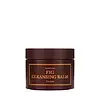What's inside
What's inside
 Key Ingredients
Key Ingredients

 Benefits
Benefits

 Concerns
Concerns

 Ingredients Side-by-side
Ingredients Side-by-side

Ethylhexyl Palmitate
EmollientCaprylic/Capric Triglyceride
MaskingSorbeth-30 Tetraoleate
EmulsifyingSynthetic Wax
AbrasiveSynthetic Beeswax
Emulsion StabilisingButyrospermum Parkii Butter
Skin ConditioningAscorbic Acid
AntioxidantPanthenol
Skin ConditioningTocopherol
AntioxidantOlea Europaea Fruit Oil
MaskingGlycerin
HumectantButylene Glycol
HumectantBenzyl Glycol
SolventCitrus Paradisi Fruit Extract
Skin ConditioningMalpighia Glabra Fruit Extract
Skin ConditioningPunica Granatum Fruit Extract
AntioxidantPyrus Malus Fruit Extract
Skin ConditioningCitrus Limon Fruit Extract
MaskingVitis Vinifera Fruit Extract
Skin ConditioningCitrus Aurantium Dulcis Juice
Skin ConditioningCitrus Aurantium Dulcis Leaf Extract
Skin ConditioningCitrus Aurantium Dulcis Fruit Water
MaskingCitrus Aurantium Dulcis Flower Extract
Skin ConditioningCitrus Aurantium Dulcis Peel Extract
Emulsion StabilisingRaspberry Ketone
MaskingWater
Skin ConditioningEthylhexylglycerin
Skin Conditioning1,2-Hexanediol
Skin ConditioningParfum
MaskingHelianthus Annuus Seed Oil
EmollientDaucus Carota Sativa Root Extract
Skin ConditioningBeta-Carotene
Skin ConditioningEthylhexyl Palmitate, Caprylic/Capric Triglyceride, Sorbeth-30 Tetraoleate, Synthetic Wax, Synthetic Beeswax, Butyrospermum Parkii Butter, Ascorbic Acid, Panthenol, Tocopherol, Olea Europaea Fruit Oil, Glycerin, Butylene Glycol, Benzyl Glycol, Citrus Paradisi Fruit Extract, Malpighia Glabra Fruit Extract, Punica Granatum Fruit Extract, Pyrus Malus Fruit Extract, Citrus Limon Fruit Extract, Vitis Vinifera Fruit Extract, Citrus Aurantium Dulcis Juice, Citrus Aurantium Dulcis Leaf Extract, Citrus Aurantium Dulcis Fruit Water, Citrus Aurantium Dulcis Flower Extract, Citrus Aurantium Dulcis Peel Extract, Raspberry Ketone, Water, Ethylhexylglycerin, 1,2-Hexanediol, Parfum, Helianthus Annuus Seed Oil, Daucus Carota Sativa Root Extract, Beta-Carotene
Cetyl Ethylhexanoate
EmollientFicus Carica Fruit Extract 7.8%
HumectantPEG-10 Isostearate
EmulsifyingPEG-20 Glyceryl Triisostearate
EmollientPolyethylene
AbrasiveSynthetic Wax
AbrasiveCaprylic/Capric Triglyceride
MaskingEclipta Prostrata Extract
Skin ConditioningCorallina Officinalis Extract
Skin ConditioningCurcuma Longa Root Extract
MaskingMelia Azadirachta Bark Extract
AntimicrobialMelia Azadirachta Flower Extract
Skin ConditioningMelia Azadirachta Leaf Extract
Skin ConditioningMoringa Oleifera Seed Oil
EmollientOcimum Sanctum Leaf Extract
Skin ConditioningSodium Hyaluronate
HumectantSorbitan Sesquioleate
EmulsifyingCaprylyl Glycol
EmollientEthylhexylglycerin
Skin ConditioningParfum
MaskingCetyl Ethylhexanoate, Ficus Carica Fruit Extract 7.8%, PEG-10 Isostearate, PEG-20 Glyceryl Triisostearate, Polyethylene, Synthetic Wax, Caprylic/Capric Triglyceride, Eclipta Prostrata Extract, Corallina Officinalis Extract, Curcuma Longa Root Extract, Melia Azadirachta Bark Extract, Melia Azadirachta Flower Extract, Melia Azadirachta Leaf Extract, Moringa Oleifera Seed Oil, Ocimum Sanctum Leaf Extract, Sodium Hyaluronate, Sorbitan Sesquioleate, Caprylyl Glycol, Ethylhexylglycerin, Parfum
 Reviews
Reviews

Ingredients Explained
These ingredients are found in both products.
Ingredients higher up in an ingredient list are typically present in a larger amount.
This ingredient is an emollient, solvent, and texture enhancer. It is considered a skin-softener by helping the skin prevent moisture loss.
It helps thicken a product's formula and makes it easier to spread by dissolving clumping compounds.
Caprylic Triglyceride is made by combining glycerin with coconut oil, forming a clear liquid.
While there is an assumption Caprylic Triglyceride can clog pores due to it being derived from coconut oil, there is no research supporting this.
Learn more about Caprylic/Capric TriglycerideEthylhexylglycerin (we can't pronounce this either) is commonly used as a preservative and skin softener. It is derived from glyceryl.
You might see Ethylhexylglycerin often paired with other preservatives such as phenoxyethanol. Ethylhexylglycerin has been found to increase the effectiveness of these other preservatives.
Parfum is a catch-all term for an ingredient or more that is used to give a scent to products.
Also called "fragrance", this ingredient can be a blend of hundreds of chemicals or plant oils. This means every product with "fragrance" or "parfum" in the ingredients list is a different mixture.
For instance, Habanolide is a proprietary trade name for a specific aroma chemical. When used as a fragrance ingredient in cosmetics, most aroma chemicals fall under the broad labeling category of “FRAGRANCE” or “PARFUM” according to EU and US regulations.
The term 'parfum' or 'fragrance' is not regulated in many countries. In many cases, it is up to the brand to define this term.
For instance, many brands choose to label themselves as "fragrance-free" because they are not using synthetic fragrances. However, their products may still contain ingredients such as essential oils that are considered a fragrance by INCI standards.
One example is Calendula flower extract. Calendula is an essential oil that still imparts a scent or 'fragrance'.
Depending on the blend, the ingredients in the mixture can cause allergies and sensitivities on the skin. Some ingredients that are known EU allergens include linalool and citronellol.
Parfum can also be used to mask or cover an unpleasant scent.
The bottom line is: not all fragrances/parfum/ingredients are created equally. If you are worried about fragrances, we recommend taking a closer look at an ingredient. And of course, we always recommend speaking with a professional.
Learn more about ParfumSynthetic Wax is created from fossil fuels such as natural gas. It is used to enhance texture, adjust pH, and as an occlusive.
It may also be used as an abrasive ingredient to exfoliate the skin.
Synthetic Wax may not be fungal acne safe.
Learn more about Synthetic Wax